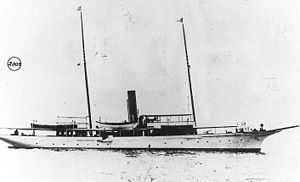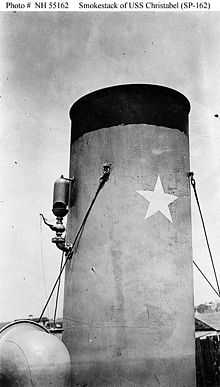Action of 21 May 1918
| Action of 21 May 1918 | |||||||
|---|---|---|---|---|---|---|---|
| Part of World War I Atlantic U-boat Campaign | |||||||
 USS Christabel in 1917. | |||||||
| |||||||
| Belligerents | |||||||
|
|
| ||||||
| Commanders and leaders | |||||||
|
|
| ||||||
| Strength | |||||||
| 1 armed yacht | 1 submarine | ||||||
| Casualties and losses | |||||||
| none | 1 submarine damaged | ||||||
| The American armed yacht was escorting a British merchant ship during the engagement. | |||||||
The Action of 21 May 1918 was a naval engagement of World War I fought between an American armed yacht and a German submarine in the Atlantic Ocean off Spain.
Background
In May 1918, the Great War had been raging for four years and the Germans were making every attempt possible to sink enemy shipping which fueled the war in Europe. On 24 May 1918, the fight was still at hand when USS Christabel—under Lieutenant Commander M. B. McCord—sighted a distinctive oil slick while escorting the slow British steamer Danse north from La Pallice to Quiberon Bay. Unknown at the time, a German submarine—commanded by Lieutenant Commander Wilhelm Kisewetter—was nearby.
Danse was about 8 mi (7.0 nmi; 13 km) behind the main convoy of allied merchant ships, making about 7.5 kn (13.9 km/h; 8.6 mph) with Christabel off her port bow. The North Atlantic was smooth, the weather was clear and there was no wind.
Action
Once the allied convoy was within 2 mi (1.7 nmi; 3.2 km) of Île d'Yeu, a well-defined oil slick was sighted between the American warship and the British steamer, off Danse′s port bow. Christabel cruised over to the slick for better observation but saw nothing to further indicate a German submarine's presence. The convoy continued for a little while when at 17:20 the wake from UC-56 was spotted by the officer-of-the-deck and a lookout, about 600 yd (550 m) off the port quarter.
Christabel was—at this time—about 300 yd (270 m) from the port bow of Danse. Christabel headed for the wake, making all possible speed, which was around 10.5 kn (19.4 km/h; 12.1 mph), whereupon the wake disappeared and a number of oil slicks were seen. The U-boat had apparently submerged. The American commanding officer ordered his ship to follow this oil for as long as possible and at 17:24—believing that his ship was just ahead of the submarine—Christabel′s crew dropped a depth charge, but nothing resulted although the charge exploded.

The action was over for now and the allied vessels continued northward. At 19:00, the convoy changed course, following the contour of the Spanish coast, making about 9 kn (17 km/h; 10 mph) for almost two hours when Christabel encountered the German U-boat once again. This time at 20:52, Christabel was astern, making about 11 kn (20 km/h; 13 mph) to catch up with the convoy. The German submarine was sighted by lookouts who witnessed a periscope roughly 200 yd (180 m) off the starboard beam.
Her commander was quickly notified, and Christabel turned toward the U-boat when the periscope disappeared under the water. At 20:55, a depth charge was dropped which detonated 10 seconds afterward. A second charge was dropped a few moments later. No secondary explosion was heard after the explosion of the first charge but after the sound of the second depth charge a third, "very violent", explosion was heard which threw up a large water column close to Christabel 's stern.
An "enormous" amount of debris from the damaged submarine was seen, mixed in with the water column of the third explosion. Christabel was then ordered to turn and cruised in the vicinity of UC-56 's position when she was engaged. The crew of the American armed yacht noticed a quantity of thick, black oil and splintered pieces of wood. There were also very large oil bubbles rising to the surface, no doubt belonging to UC-56.
Sometime during the dropping of the depth charges, a number of other charges—which were prepared and live aboard Christabel—were shaken lose and Ensign Daniel Augustus Joseph Sullivan reacted quickly by jumping on top of them and securing the charges before they could detonate. Sullivan would later be awarded the Medal of Honor for "extraordinary heroism" in this action.
Aftermath

Nothing further was heard of this submarine before it surfaced after the engagement; it was not capable of submerging again due to battle damage. On 24 May 1918, the U-boat arrived at Santander, Spain after a dangerous three-day voyage in a severely damaged condition. The crew of UC-56 were interned, the Germans reported to the Spanish authorities that their submarine had been seriously damaged by Christabel, and that they had had no choice but to take refuge in a neutral port.[1] It was originally thought that the yacht sank the German submarine so a traditional white star was painted on Christabel 's smoke stack which represented a U-boat kill. Although the American ship did not actually sink the German vessel, Christabel was still responsible for protecting her convoy and inflicting serious damage on an enemy submarine which resulted in internment.
No Allied vessels were damaged as the German submarine was spotted and attacked before it could line up for an attack. No German casualties were reported.
See also
References
Notes
- ↑ Helgason, Guðmundur. "WWI U-boats: UC-56". U-Boat War in World War I. Uboat.net. Retrieved 29 September 2012.
Bibliography=
- Halpern, Paul G. (1995). A Naval History of World War I. New York: Routledge. ISBN 978-1-85728-498-0.
- Drechsel, Edwin (1994). Norddeutscher Lloyd, Bremen, 1857–1970: History, Fleet, Ship Mails, Volume 1. Vancouver, British Columbia: Cordillera Pub. Co. p. 191. ISBN 978-1-895590-08-1. OCLC 30357825.
- Roessler, Eberhard (1997). Die Unterseeboote der Kaiserlichen Marine. Bonn: Bernard & Graefe. ISBN 978-3-7637-5963-7.
- Putnam, William Lowell (2001). The Kaiser's Merchant Ships in World War I. Jefferson, North Carolina: McFarland. ISBN 978-0-7864-0923-5. OCLC 46732396.
- Wilson, Henry Braid. An account of the operations of the American Navy in France during the War with Germany (1919?)